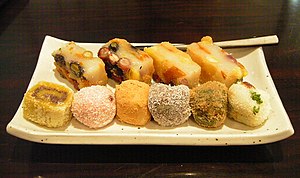トック
Tteok/ja
トック (Korean: 떡) は、韓国の餅の総称である。主にもち米やうるち米といった様々な穀物の粉を蒸して作られる。蒸した粉は、ついたり、形を整えたり、フライパンで焼いたりしてトックにすることも可能である。また、炊いた穀物をついてトックを作る場合もある。
 | |
| Alternative names | 餅 |
|---|---|
| Type | 餅 |
| Place of origin | 韓国 |
| Main ingredients | 粉は、もち米やうるち米など、様々な穀物から作られる |
| Variations | 蒸し、つき、茹で、焼き |
トックは、デザートや季節の珍味としてだけでなく、食事としても食べられている。ナッツ、果物、花、ナムル(ハーブや野草)などを使って様々な色、香り、形に仕上げた手の込んだものから、家庭料理に使われるシンプルな白い米餅まで多岐にわたる。多くの種類のトックに使われる一般的な材料には、小豆、大豆、緑豆、ヨモギ、カボチャ、栗、松の実、ナツメ、ドライフルーツ、ゴマとごま油、蜂蜜などがある。
トックは通常、分け合って食べられる。霊に供えられるトックは「ボットック」(「福餅」)と呼ばれ、近所の人や親戚と分け合われる。また、宴会、儀式、様々な祭りのイベントで使われる祝いの食べ物の一つでもある。「トックク」(「餅スープ」)は旧正月を祝って、「ソンピョン」は収穫祭である秋夕に分け合って食べられる。
歴史
餅の歴史は、原始農耕社会にまで遡る。これは、紀元前7世紀から8世紀頃にはこの地で種まきや耕作の記録が見られること、あるいはその時代の磨石(果実を挽く際に使う平らな石)や石臼(小さな石製の臼)などの遺跡から、ほとんどのものが発見されているためと考えられている。
餅の起源は先史時代に始まり、混じり合った穀物を原始的な脱穀工程で得られた粗い粉を、調理器具を使わずに焼いたり、フライパンで焼いたりして作られていた。
トック作りに使われる道具
以下は、伝統的な韓国式で**トック**を作るために使用される調理器具である。
- 『キ』(키)、箕(み)
- 『イナムバク』(이남박)、米洗いボウル
- 『バガジ』(바가지)、ひょうたん型柄杓(ひしゃく)
- 『オンベギ』(옹배기)と『ジャベギ』(자배기)、大きくて丸い陶器製のボウル
- 『チェ』(체)と『チェッタリ』(쳇다리)、篩(ふるい)と篩脚
- 『メットル』(맷돌)、石臼
- 『チョルグ』(절구)と『チョルグッコンギ』(절굿공이)、臼と杵(きね)
- 『アンバン』(안반)と『トクメ』(떡메)、木製の餅つき板と木槌動画
- 『シル』(시루)と『シルミッ』(시루밑)、土製蒸し器と底に敷くマット
- 『ソッ』(솥)と『コングレ』(겅그레)、大釜と蒸し器用網
- 『ポンチョル』(번철)、厚手のフライパン
- 『チェバン』(채반)、竹製のざる
- 『トクサル』(떡살)、木製のトック模様付けスタンプ
種類
トックは、主に以下の4つのカテゴリーに分けられる:
- 「蒸し餅」(찌는 떡)
- 「つき餅」(치는 떡)
- 「茹で餅」(삶는 떡)
- 「焼き餅」(지지는 떡)
蒸し餅は、米粉やもち米粉を「シル」(시루)という大型の土器製蒸し器で蒸して作られるため、しばしば「シルットック」(시루떡)と呼ばれます。これはトックの最も基本的で古い形態と考えられている。 つき餅は、最初に蒸した後に、つき板や臼を使ってつく。 焼き餅を作る際は、餅の生地をパンケーキのように平らにして、植物油でフライパンで焼く。形を整えるトックは、生地を熱湯でこねてから、丸い形に成形して作られる。
Steamed tteok
The main ingredients for steamed tteok or "sirutteok" are rice (멥쌀, mebssal in Korean) or glutinous rice (찹쌀 chapssal), and sometimes they are mixed together. In some cases, other grains, beans (azuki beans or mung beans), sesame seeds, wheat flour, or starch are mixed with the rice. Various fruits and nuts are used as subsidiary ingredients, such as persimmons, peaches or apricots, chestnuts, walnuts, and pine nuts. In addition, marinated vegetables or herbs can be used to flavor the tteok. Danggwi leaves (Ostericum grosseserratum), seogi mushroom (manna lichen), radish, artemisia, pepper, and cheongju are the most common flavorings, and honey and sugar are used as sweeteners.
In order to make steamed tteok or sirutteok, rice or glutinous rice is soaked in water for a while, then ground. The prepared rice flour is put in a siru and steamed. According to steaming method, sirutteok is subdivided into two groups: seolgitteok (설기떡), which is shaped into a single large lump, and kyeotteok (켜떡), which consists of multiple layers with adzuki bean powder or other bean powder. Seolgitteok is also called muritteok (무리떡), which is regarded as the most basic form of sirutteok because it is made only of rice. When making kyeotteok, rice and glutinous rice are mixed. The name kyeotteok derives from the adverb kyeokeyo (켜켜, literally "layered") in Korean because this tteok is made in layers.
- Baekseolgi (백설기) - a variety of siru tteok. It literally means white snow tteok and is made of white rice.
- Kongtteok (콩떡) - tteok made with various kinds of beans
- Jeungpyeon (Korean: 증편) or Sultteok (Korean: 설떡)- tteok made with makgeolli (unfiltered rice wine)
- Mujigae tteok (무지개떡) - literally "rainbow tteok"; this variety of tteok has colorful stripes. The tteok is used especially for janchi (잔치), a Korean banquet, party, or feast such as dol (celebrating a baby's first birthday), Hwangap (celebrating a 60th birthday), or gyeolhon janchi (wedding party)
Pounded tteok
In traditional preparations, pounded tteok is made by pounding rice or glutinous rice with utensils called jeolgu and jeolgutgongi or tteokme and anban. Injeolmi (tteok coated with adzuki bean powder or roasted soybean powder), garaetteok (가래떡 cylinder-shaped white tteok), jeolpyeon (절편 patterned tteok) and danja (단자 glutinous tteok ball coated with bean paste)" are the most commonly eaten pounded tteok.
Rice and glutinous rice are hulled to make grain particles or powder and then steamed in a siru (earthenware steamer) and pounded with utensils. The pounded tteok is divided by rice type into glutinous pounded tteok (찹쌀도병 chapssal dobyeong) and non-glutinous pounded tteok (맵쌀도병 mapssal dobyeong). Injeolmi, a representative of glutinous pounded tteok, varies in accordance with gomul types (고물, coating made with bean powder, sesame seeds, or sliced jujubes) or subsidiary ingredients mixed into the steamed rice while pounding on the anban. Patinjeolmi (팥인절미), and kkaeinjeolmi (깨인절미) are examples for the former, coated with red bean powder and sesame, respectively. In ssuk injeolmi (쑥인절미) and surichwi injeolmi (수리취인절미), ssuk (Artemisia indica) and surichwi (Synurus deltoides (AIT.) NAKAI) are added.
- Garae-tteok (가래떡; also called huin tteok, 흰떡, literally "white tteok") – tteok formed into a long white cylinder. The thinly sliced garae tteok is used for making tteok guk.
- Omegi tteok (오메기떡) – traditional tteok of Jeju Island, the biggest island in Korea
Shaped tteok
- Ggul tteok (꿀떡) - literally means "tteok with honey" but the tteok is stuffed with Korean syrup. Ggul tteok is similar to songpyeon in shape, but smaller in size
- Songpyeon (송편) - eaten during Chuseok holiday (추석), Korean thanksgiving day
- Gochitteok (고치떡)
- Ssamtteok (쌈떡) - tteok used for ssam (쌈, food wrapped in a leaf)
- Dalgal tteok (닭알떡) - named after dalgal (달걀 or 계란 egg)
- Gyeongdan - Inside these rice balls are usually red bean or sesame paste. The balls are usually dipped and covered in black sesame or other powders.
- Bupyeon, consisting of dough made of glutinous rice flour with a sweet filling and coated in gomul (powdered beans).
Pan-fried tteok
- Hwajeon - small, sweet pancakes made of flour of glutinous rice and decorated with flower petals of the Korean azalea, chrysanthemum, or rose.
- Bukkumi (부꾸미), pan-fried sweet tteok with various fillings in a crescent shape
- Juak (주악), made of glutinous rice flour and stuffed with fillings such as mushrooms, jujubes, and chestnuts, and pan-fried. Juak are colored with natural coloring and covered with sugar or coated in honey.
その他の種類
- スットック(쑥떡)
- カッセクピョン(각색편)
ギャラリー
トックを使った料理
関連項目
- [[Nian gao]/ja], 類似の中国語カテゴリ
- 韓国料理
- List of Korean desserts/ja
- List of steamed foods/ja
外部リンク
- Information about Tteok from lifeinkorea.com
- Information about Dano and Korean desserts
- Video about Tteok
- (in Korean) General information, origin and recipe of Tteok from Tteok & Kitchen Utensil Museum
- (in Korean) Information about and recipe for Tteok
| この記事は、クリエイティブ・コモンズ・表示・継承ライセンス3.0のもとで公表されたウィキペディアの項目Tteok(15 June 2025, at 02:06編集記事参照)を翻訳して二次利用しています。 |